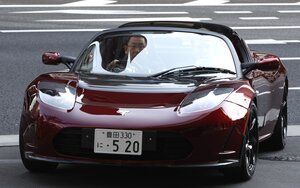Hybrid cars? OK. All-electric Tesla? An eco-thriller!
Hybrid cars still hold onto the combustion past, but the Tesla shows how all-electric cars can be a sporty and eco-friendly alternative.

Toyota Motor Corp. President Akio Toyoda (left), flanked by Tesla Motor Inc. Chief Exective Elon Musk, drives a Tesla Roadster electric car upon their arrival for a news conference in Tokyo Nov. 12. Toyota, maker of the Prius, the world's best-selling hybrid car, has been partnering with Tesla since May.
Issei Kato/Reuters
Boston
A small pothole sends a jolt to my tailbone. This car’s suspension is tight, its tires low-profile, with barely any sidewall between rim and road.
But mashing the accelerator pedal practically touches off St. Elmo’s fire. The next stoplight comes up fast. Absurdly fast, in an unnervingly quiet rush. Golf cart meets F-16.
I am folded into a Tesla Roadster 2.5 Sport, the $100,000-plus, all-electric exotic that looks a lot like a Lotus Elise and, from a performance standpoint, leaves most hybrid cars in its electron cloud.
Tesla is a boutique automaker, and that’s where the Roadster’s chassis and some other parts are sourced, though it’s more than 90 percent original, including its lovely, lightweight, partly carbon-fiber body, this one in Batmobile black.
It has been raining on and off in Boston. Wet leaves blow around in the chill. Even mid-day there are too many other cars on the river roads along the Charles to properly wring this thing out. Here a Suffolk County sheriff. There a Statie.
But the Roadster can’t cloak its personality. It’s all urges and surges. Loaded with torque, It does zero to 60 in 3.7 seconds – comparable to (maybe even a coat-of-paint faster) than Ferrari’s frighteningly quick F430. (In fairness, that Italian job also has a top-end speed of about 200 m.p.h.; Tesla’s is 125.)
Electric vehicles are hardly new – the newsprint Monitor was delivered locally by electric trucks before World War I – but they’ve entered a new era. Tesla is, so far, the one true electric supercar. It pretty neatly redefines “plug and play.”
You’ve probably heard of this exotic. It’s the one George Clooney and Leonardo DiCaprio waited online to get.
I waited four years just to get in it. In 2006 I saw its predecessor being built in San Carlos, Calif. Executives and engineers (who’ve since relocated to Palo Alto) were very forthcoming, but there was no tester on hand. Everything had wires hanging out of it.
It was worth the wait.
I’ve flogged a modern Mustang GT on a straight back road. Run a 12-cylinder BMW hard on the Autobahn. Even turned in quarter miles on a drag strip in a Jaguar XKR.
This is different. In terms of power on tap, it’s more like twisting the throttle in first gear on a Suzuki GSX-R sport bike – but without the screaming harmonics. (Frankly, that’s about the only shortcoming of this eco-exotic.)
Fairly restrained today among Boston’s Kias and Volvos, the Roadster is sure-footed. The steering wheel feeds back every ripple in the road.
Even though it’s a rear-wheel-drive car, the Roadster’s rear end won’t quite break loose on wet pavement in a hard on-ramp turn, with acceleration. Weight is well distributed.
Let off the accelerator and the electric-drive system slows the car fast. Braking, when needed, is regenerative. The Roadster’s advertised range is 245 miles with its 900-lb. lithium-ion battery pack. Fully charging it is basically an overnight affair.
On the whole, electrics have seen no overnight success. General Motors’s EV1 famously failed (or was made to fail). It took Toyota what seemed like forever just to produce a plug-in Prius. Aftermarket modifiers had to take the lead.
GM’s long-anticipated Volt – talked up as an electric car and finally rolling out this month– comes with a small combustion engine dedicated to battery-charging.
One reason for the hesitant adoption: Many drivers have “range anxiety.” That should fade as more businesses and communities add charging stations.
Sure, the Nissan Leaf is a mainstream all-electric. There is an all-electric scooter. But like the Volt, most of these post-petroleum vehicles can't quite let go of combustion technology.
Tesla’s supercar signals that, like everything else, some exotics have tilted eco. That could point to a values shift even among conspicuous consumers who traditionally haven’t given any thought to the price of premium gas (or to tailpipe emissions).
So along with practical little EVs (electric vehicles) that look like moon-base shuttles (Aptera) or Smart cars that have been squeezed (Lumenco SMERA), you also have pedigreed performers that are getting greener by degrees.
The new Porsche 918 is a stunning gas-electric hybrid that leans heavily on its electric thrusters. The Jaguar C-X75 (still a concept, just recently unveiled in Paris) uses one electric motor on each wheel – each making 195 h.p., for a synchronized 780 h.p. It also use micro turbines, which burn gas, natural gas, diesel, or biofuel, to generate supplemental electricity. (They’re provided by a jet-engine manufacturer.)
Still, Tesla’s Roadster pretty much owns its crackling niche. Coming next year: its fully electric Model S sedan. Another silent streak, this time with room for the family. Tesla’s a firm with some juice.
